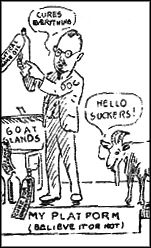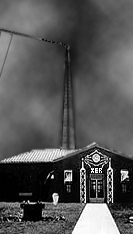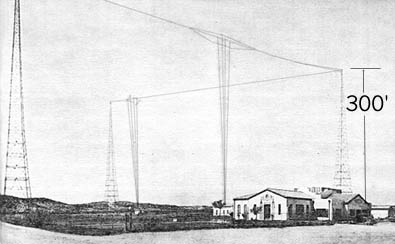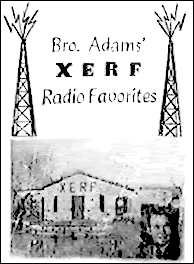A quack doctor.
A million watts.
Goat testicles.
Hitler.
Wolfman Jack.
Now, this is radio...
People think they're just normal, scuzzy AM stations, only a little scuzzier and using the last letter in SEX to get noticed.
People ask me why they hear Spanish on them.
Many, I'd say at least half, don't believe my answer, which is that XE and XF are the Mexican radio prefixes, and that they are in another country. Don't AM radio waves stop at the border? Wasn't Wall Of Voodoo just kidding in "Mexican Radio?"
Other people turn off today's syndicated crud, and moan that radio broadcast standards have never been lower. Well, these fine folks apparently don't know about XER, XERA, and XERF (good call!). These letters were all used by the megawatt border blaster that sold a nation on goat testicles, and forever defined what real AM radio would be about.
And the best part? It's all true.

The Kansas Navy
John Romulus Brinkley and 1920s Kansas were a marriage made in heaven. He actually came from North Carolina, but it didn't matter. Doctor Brinkley had a genuine medical diploma, two of them in fact, both very impressive looking, both from schools that never made it into the medical college guide. Doc was one of those smooth talkers, with a voice that could charm the moon right out of the sky, definitely the type who could sell the proverbial iceboxes in Alaska.
Increasingly, though, what Doctor sold was virility. Bedroom problems? Limp weenie? Tired by nine P.M.? Old get up and go just got up and went? Doctor could fix you right up.
Brinkley, at his clinic in Milford, Kansas, could give you his super-duper prostate "cure" - for a price. You got weird injections, some of them rather toxic, others just colored saline. You got magic elixirs to drink. For your morale, you got plenty of fundamental Christianity and pseudo-Biblical mumbo-jumbo.
If you were really, really desperate, and really, really rich, Doctor could even give you the guaranteed sex cure of all time. For $750, a king's ransom in the early 20s, you got his infamous goat gland operation. In this procedure, your, uh, family jewels were fitted with tiny slivers of tissue from the testicles of castrated goats. After all, nobody ever saw an impotent goat, now did they?
The major human sex organ is the brain, and Doc's expensive placebos worked just often enough. Word spread about his magic youth machine. Most opted for cheaper miracles, but at least a few really did drop the big bucks, and their pants, to gain from a goat's loss. There's a rumor (in Los Angeles everything is a rumor) that more than one fading Hollywood matinee idol paid to let this guy cut into their manhood.
Doctor couldn't spend the money fast enough, and he spent it pretty fast, on diamonds, nice cars, big houses, an airplane, a drug store, and a bank. Like most big spenders, Brinkley was popular, hanging out with hail-fellow Chamber of Commerce types. A fraternal group called the Kansas Navy made him an honorary admiral. The title seemed appropriate for this con-man somehow, in a place where the deepest body of water is the Missouri River, and even half of that is in another state.
So it's no surprise that, in 1922, Doc saw the potential of these new-fangled radio stations, and started one of his own. Nobody knew at the time that KFKB, "Kansas First, Kansas Best," would help invent AM radio.

Doctor Invents Media Politics
Now, Doctor could put on a medicine show with the best of them. He had a nice big truck, called "Ammunition Train No. 1," that opened out to a stage, complete with PA system and movie screen. Doc, however, was among the first to realize that radio waves traveled way faster than anything Chevy could ever make.
KFKB was a medicine show of the air, with the perfect AM format, then, now, forever. It played plenty of friendly, folksy, country-western tunes, often live, from well-known Kansas musicians. It rented time to friendly, folksy preachers on a pay-before-you-pray basis. Mostly, though, it sold snake oil, Brinkley's snake oil, all over the Midwest. Doc reserved a couple of the best hours for his own talk shows and infomercials, where he answered letters with friendly, folksy, medical advice, all delivered in a radio voice that remains disquietingly soothing in old air checks played today.
As a con man, Brinkley intuitively understood clear-channel AM radio, with its long-distance reception late at night. In the prime, family hours, radio was a living-room medium, as TV is now. Brinkley aired plain old entertainment for plain old folks, heavy on the ahh-haah bands.
Late at night, though, when people woke up alone, clear-channel AM was the bedroom medium, talking personally to every listener all by themselves alone, with a persuasive power unmatched by anything since. So many letters poured into Doc's clinic that he built Milford a bigger post office. KFKB was officially recognized in 1929 as America's most popular radio station. This was not a good year for the goats of Kansas.
Emboldened, Brinkley filed for a power increase to 5000 watts in 1930. This was too much for the Kansas City Star, which just happened to own a competing radio station. The paper did a series of muckrakings, costing Brinkley his medical license, and putting KFKB's future into serious doubt. The good Doctor came up with a typical Brinkley solution. He put on the biggest and best snake-oil show yet, by running for governor of Kansas. He probably won. We say "probably" because a lot of the ballots seemed to disappear, not that the voting had been any more honest than the count.
It would appear, then, that mass-media politics are older than most of us think.

Fire From Below
Brinkley sold KFKB for a bundle, but he was too crafty to give up his commanding presence on the Kansas airwaves. Sure, the medical examiners chased him all the way down to the West Texas border hamlet of Del Rio. Sure, any lesser scoundrel would have packed it in right there. Doctor, however, had another inspiration. In 1931, he looked across the river, and he made his stand. He invented Mexican border radio.
Border radio is like border anything else. Some things just work better over the line a bit. Mexican workers get into trouble if they cross the Rio Grande, but Mexican photons don't. North of the river, there was no way, no matter, no how, never, ever, ever, any station besides WLW stood the proverbial snowball's chance of permission to put some real wattage into the Aether. South of the river...
Brinkley's first border blaster, "Good Old XER," was designed to reach back into Kansas. Doctor kept a studio and a political base up there, running for governor twice more, feeding the transmitter down south via dedicated long-distance phone lines costing $10,000 depression dollars a month.
To defray this punishing expense, Good Old XER combined the time-honored Brinkley format of country music and folksy chats with what became the prototypical, pay-before-you-pray, dollar-a-holler, Southern AM radio station. Along with KFKB's proven programs and stars, Doctor kept three prime slots for himself. "Hey, farmer, that old prostate hurts on these cold mornings, does it not?" Remaining air time was for sale to anyone with postage to Doc's P.O. box in Del Rio, a recording, and the cash. Pay before you pray. Dollar a holler.
Doctor probably saved depression-era Del Rio. Giving up politics in the mid-30s, he moved everything there. He set up a new prostate clinic in the town's hotel. He built a huge estate, with a swimming pool, a tennis court, and acres of gardens. Its 3-story living room might have been an acre or so all alone, with an enormous chandelier and a mechanical pipe organ that played itself. He bought a huge yacht, the John R. Brinkley III. This majestic vessel needed a crew of 22, and cost $1000 a day when he used it.
When you got to Del Rio, you could look southward across the river to Ciudad Acuña, and see Good Old XER's 300-foot towers, holding up a majestic skywave antenna. Its 75 kW, 840 kHz transmitter practically warmed your nose when you did. All these photons came from a beautiful hacienda with a fountain in front, two radio towers framing the front door, and the call letters dramatically outlined in thunderbolts above.
Good Old XER was a one-station network, making it clear up to Canada at night. It showed up in a lot of log books. With its country music stars, Mexican studio band, and the good doctor, it was just as popular as KFKB, and as lucrative as WLW.
WLW. Wherever people talked about AM broadcasting, these letters were magic. It was The Big One, The Nation's Station, Whole Lotta Watts, World's Largest Wireless, the only radio in the US with 500 kW. Brinkley, being Brinkley, knew he could do better. WLW, up in Ohio, was using an "experimental" license that had to be renewed every six months. Nobody had to experiment in Mexico. The good Doctor hired some of the same RCA engineers who'd learned on the Cincinnati supermachine, and asked them for a bigger one. The Mexican radio bureau granted the new call of XERA, and Doctor built the biggest damn radio in the world.
Nobody knows just how big. Carrier was listed as 500 KW, but the engineer types put in the goat glands to make considerably over a megawatt on a good day. They'd learned a lot from WLW. Doctor got a real nice box. He was so excited about his big PA tubes, his firebottles, his flamethrowers, his huge $1600 glass things with their water-cooling jackets, that he went with the engineer to pick them up himself.
The transmitter room was the classic science-fiction-movie idea of a radio, with rack after rack of black, ominous panels, covered with meters, water valves, buttons, lights, and glass portholes for looking in on the expensive circuits. Some of these advanced designs made it into World War II radar, not to mention other super-powered broadcast facilities yet to come.
At night, when the doctor was in, XERA owned the world. From its high-gain antenna, it blasted its way north, right through Canada, all the way over the Pole, and into Russia with a clear signal. For many years, the NKVD/KGB spy school used it for English practice.

Now, there have always been plenty of goats in Del Rio, and a few gave up their manhood for the good Doctor's financial gain. However, most of Brinkley's well-heeled patients went there, and later to Arkansas, for Doc's lesser prostate surgery or miracle gland potions. Once you got on Doc's mailing list, you never got off, receiving pitches at two-week intervals for the rest of your life.
Meanwhile. XERA sold what AM stations sell best. Ads went out for Doctor's mail order and drugstore nostrums, usually just colored water, but guaranteed good for anything that ailed you. People gladly plunked out 100 depression dollars for one case. Add it all up, and Brinkley made around $12 million in five years. XERA burned electricity like nobody's business, but money came out the other end.
Other people got the hint, and the border radio industry was off and running. Power companies added generators, antenna farms sprouted from Baja all the way east, and RF broadsided the defenseless U.S. from one end to another, selling Crazy Water Crystals, warped guitars, bad paintings of Jesus, cheaply bound Bibles, fearsome-looking medical gadgets that buzzed and made ozone, and everything else from the fertile imaginations of outlaw broadcasters on high-wattage X-stations. Preachers fought off Satan right on-mike, screamed about killing the rich and eating them, and asked old ladies to send those life savings right on down south for Jesus. Whacko politicians advocated everything from free love to chastity belts.
Frito-Bandito cliches notwithstanding, the Mexican government knew exactly what was going on. It winked at the border blasters, their English station IDs, their mailing addresses and studios up north, their tendency to run what they brung, ignoring anything written on their licenses. In fact, the Mexicans encouraged all this, and it wasn't from corruption or bribery. You see, they were running a scam of their own - a radio jamming war.
Mexico had long protested interference from US AM stations at night, demanding that the FCC create several clear channels all the way up to Canada. Nothing had ever come of this. Now, in 1935, Mexico would return the fire.
The United States lost this war, after Brinkley veered off into Nazi politics. He became a Hitler sympathizer, dropping the good-doctor act for a different kind of mass psychology. He might or might not have actually met Der Fuhrer, depending on whose story you want to believe. Forget the Kansas state house. Here, we're talking about the whole world, for a thousand years. Pretty heavy stuff for a kid from Carolina.
The US government had put up with goat glands, but those didn't sabotage FDR's efforts to swing pre-war, public opinion over to the Allies. This was way more serious stuff. It did Brinkley in.
First came the Brinkley Act, still vigorously enforced today, banning any cross-border studio-transmitter links originating in the US, including Doc's phone lines. From this point on, border blasters had do do it all from their side. A Mexican station was run off the air for this as recently as the 1990s.
Then, in 1940, the FCC gave in and granted Mexico the clear channels, in exchange for a border cleanup. Treaties were signed, pictures were taken, and Doctor was old news. The Mexicans siezed XERA and closed it down. (Another station has the call now.) Brinkley, legally bankrupt from long fights with the AMA and the IRS, went out in the only way fitting - a melodramatic decline worthy of an 18th century novel. He suffered a massive heart attack in 1941, lost a leg from circulatory collapse, and died, a broken man, a year later. The goats of the Western Hemisphere probably breathed a sigh of relief audible farther than XERA.

Howling From The South
The war might have killed Brinkley, but it didn't kill XERA. The border powerhouse quickly reappeared in the 1940s as XERF, 1570 kHz, and still all in English. The station was supposedly down to "only" 250 kW, omnidirectional, on one of those Mexican clear channels it had helped create. There were, however, regular rumors that sometimes, in the dead of night, when the electric bill was paid up, the engineers couldn't resist cranking the thing un poquito mas, permanently fading the paint on every south wall clear to Alberta. The "RF" stood for "Radio Fifteen," but all the world's nerds knew what it really stood for.
For all its wattage, XERF was kind of a nowhere station. It tried the same time-brokered format of Texas radio preachers, yee-hah bands, chatty DJs, and quack cures, but without Brinkley to pull it off. It lost money. The owner was forever in and out of legal trouble.
Fortunately, Ciudad Acuña still drew larger-than-life figures to its larger-than-life radio. The next one to happen along was Bob Smith, a skinny white kid from a tough section of Brooklyn, who had drifted from one southern US station to the next, learning his DJ gig the tough way. He had one major career problem - he insisted on playing the real, urban blues, the cynically named "race records" by the original black artists. White boys just didn't do that in the late 50s and early 60s - they played the vapid cover versions aimed at nice Caucasian folks. In Virginia, it is said, the Klan burned a cross on his lawn.
That's right - this skinny white kid with the black voice who could reach Canada without a transmitter was Wolfman Jack, the legendary radio figure who stoked a generation on the blues, and pretty much invented the sixties. Yes, he's the guy George Lucas put in the movie. Better Lucas should have told the real story though. The Wolfman did not hang out in some hayburner sucking Popsicles. The Wolfman did not play anything as sissy as the Del-Vikings. The one thing he did do was "blast that thing clear around the world," as the dorky actor said.
Now, the Wolfman washed up at XERF during a strike. He wound up more or less running the place. XERF's media karma was at work. Magic was alive. The owner had defaulted, repeatedly, on payroll and taxes, and the Federales were getting ready to sieze the station again. Somehow, though, Wolfman and others raised the money to keep the border blaster on the air. They played music people wanted to hear, all the time selling all manner of dubious products on-mike.
Wolfman lived in Del Rio and commuted over the border, his Cadillac filled with recordings and $100 bills. With no consultants, no rating books, no focus groups, no audience research, no tests, no wired-up teenagers holding red and green buttons, none of that crap, he re-invented night time radio. He plugged it into That Big Amp In The Sky, and cranked it to eleven - or at least 110% modulation - on his signature howls. If you were halfway hip in the sixties, you knew where to listen. That's all.
There was one problem. Nobody was quite sure who owned the station. Nasty letters were written, death threats were exchanged, and XERF started fitting out a private corps of security guards. The station stocked up on some gear not normally seen at a broadcast site, such as automatic weapons and plenty of ammo. The once beautiful transmitter building, already minus most of its original detailing, became even more like a fort.
Wolfman Jack liked to tell a story about what happened next. Now, everyone agrees that there was a real, border shootout, just like in the movies, the DJ diving for cover, bullets flying every which way. Wolfman, of course, always said he was there, having heard pistol shots on the air, and broken the speed record down from Del Rio in his Caddy. Others say he probably wasn't there, but that the gun battle definitely happened, followed by lots of cops poking around, lots of investigations and legal complications. No matter how you want to tell the story, it was not the Wolfman's best year.
Wolfman moved on, as all radio gypsies must, to another border blaster in a marsh by the Tijuana River, with a dead shot up to Los Angeles, and yet another emisadora muy grande. This was XERB, Rosarito Beach, BC. XERB's signal could hold its own with such L.A. giants as KFI and KNX, and certainly had no trouble whatever shooting up the Central Valley as depicted by George Lucas. It was perfect setup for the Wolfman. Now the mystery man with the huge voice and the good music could own California at night, and inspire everyone. The rest is history, and more than one great movie.
"Listen to the Wolfman howl - rock and roll is music now!" (James Taylor)
Fade Out
After Wolfman and the shootout, XERF went back to its Texas preachers and pill-pushers, plus just enough Spanish to keep the license. It fell ever farther behind the media curve. The mighty wave faltered and grew weak, as tubes aged and electricity got expensive. One account has the government taking over the station, again, in 1978. Today, it shows in the database as a 50 kW ND-1, from another site. Meanwhile, it limps along with 10 kW and an undistinguished, all-Spanish format.
A Florida video producer took a crew down to Ciudad Acuña, looking for any remains of XER/XERA/XERF. They found the awesome building, all right, but today it is a grungy, depressing garage. Equipment was removed years ago, and presumably junked. The fountain is gone, the paint is going, and buses rust nearby. Back in Del Rio, Brinkley's mansion still stands, but the grounds were sold off and bulldozed for development. A couple of English language border stations are still on, but they're no longer anything real special. As the twentieth century ends, so does its best story. Radio survives, but the real, take-no-prisoners AM of XER, XERA, and XERF has signed off.